

| HOME |
|
PHOTO |
|
RESUME | TOUR & STATEMENT | CONTACT | |
| PROJECTS |
SPANISH MOSS:
AN EFFIGY OF THE SOUTH


The paintings in this series depict Spanish Moss -- that air-nourished plant found hanging like beards on Live Oak trees throughout the southeastern United States. As a visiting artist at Florida State University in Tallahassee during March and April 1996, I was mesmerized by these exotic, enigmatic forms swaying in the breeze. Laying some on panels or canvas, I was able to "cast" their image with paint, much like particles of light filter down around objects in a darkroom to create a photogram. The paintings seemed in keeping with the idea of Florida: a skin of beauty displayed to the tourists.
But beneath this beauty lingered the visual association I'd made with the moss: that of dead bodies, lynched, swaying in mute evidence of mob violence. Had I seen too many civil rights documentaries on PBS? Or did it go deeper, really, to growing up a white boy on the south side of Chicago? I wondered what slaves just landed from Africa could have thought of it, standing new on some beach near there, and I began to read history -- of Florida, slaves, Reconstruction, lynching, race relations. As I worked, I planned to add to the paintings images or text from these histories -- a layer of violence contradicting the beauty of the moss. And the paintings themselves grew more sinister as I went along, informed, perhaps, by what I was reading.
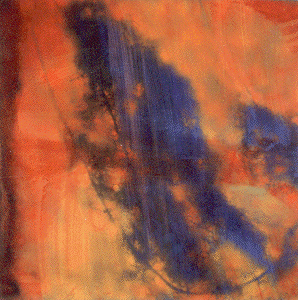 |
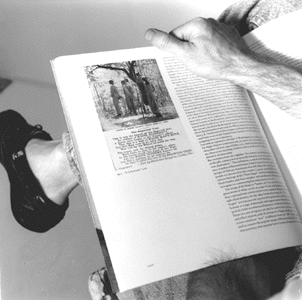 |
But when I described the
intended scope of the project to others, it seemed I had hit a
nerve. "Why do you want to do THAT?" was a common response.
"It's only you northerners on vacation that always want to
talk about that; we never talk about that stuff down here anymore."
When I mentioned Florida's role in lynching to one woman, she
exclaimed "Oh, I hope we're not THAT bad." At Pebble
Hill Plantation just up the road in Georgia, I asked someone in
the office where the slaves had lived, only to elicit a vociferous
"Sir, all the buildings you're looking at have been built
since the turn of this century. We've chosen to emphasize the
sporting era here; we really don't know much about the early days
of the plantation." I happened to be holding a book Pebble
Hill had published open to the page where it mentions the original
1840's owner had 29 slaves when he died. No mention of this in
the tourist orientation center, however, only vague references
to "when the land was cleared for cultivation." Undaunted,
I asked her who was buried in the large unkempt cemetery off at
the edge of the property and unlisted on the map. She started
to tell me about the owners' cemetery, hard by the tennis court
across the lawn
from the big house,which includes headstones for two favorite
Labrador Retrievers. I pressed on: "No, no, the huge cemetery
off in the woods with blank headstones the size of bricks."
"Oh, that's the LABORERS' cemetery," she responded,
"it's been there at least since the eighteen-NINETIES."
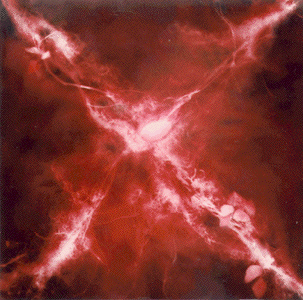 |
 |
In Natchez, Mississippi, however, on a tour of one of the mansions, someone asked (after the tour had ended and most people had already left) about the three stories' worth of small rooms built onto the back of the house. The guide, who had been so ebullient in explaining where various paintings and mirrors had come from and who came to whomever's birthday party some year, almost looked over her shoulder before responding: "That's where the slaves lived. You know, I hate to use that word, but it's the truth."
One man on the faculty at F.S.U. warned me I might be accused of slumming if I chose to put a set of racist epithets on one painting. Another pressed me for what I had at stake personally in the project, i.e. what were my credentials? And one graduate student left what she thought was an anonymous note for me on a works-in-progress exhibition flyer I had posted, charging me with being exploitative and shallow, ending with the question "A few weeks in Florida and you've gotten down to the root of it all?"
But who owns history, and how are we to learn it? Did the Nazis patent the Holocaust? Do American Indians own some copyright on Manifest Destiny? Can only a dues-paying member of the Ku Klux Klan talk about its effects on society? Who writes the histories? Whom can we trust? And, indeed, if we don't learn and talk about history, are we doomed to repeat it? Don't we all have some complicit role?
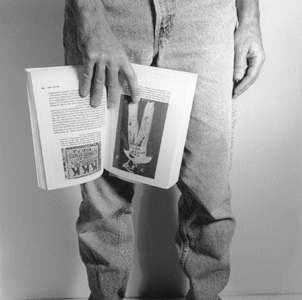 |
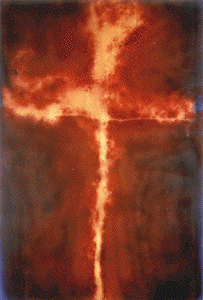 |
In the end, I chose to add nothing to the paintings. Instead, there is a set of photographs confronting the one skin of painted beauty with the violent, grisly documents of history -- some more familiar, such as the lynching photos; others not, such as the news accounts of people burned alive, eyes gouged out, genitals hacked off. But the hands holding the books in my lap do more than prop open the pages; they keep asking me if I prop up any of the ideas found in them. "Nigger," "jigaboo" and "shine" were common words on the south side of Chicago in the 1960's when block-busting (the move of one black family into an otherwise white neighborhood) and the Marquette Park riots were going on around me. Back in the 1910's when all of my grandparents came over from eastern Europe it was Catholic-bashing. Today it's gay-bashing, arab-bashing, wetback-bashing, liberal-elite-bashing. And if we consciously endorse none of the above, but happen to live in an all-white neighborhood or an all-white town or an all-white part of the country, how easy is it to forget about all of the above, to allow silence to be an even louder statement?
One curator who saw slides of this work couldn't understand why I would bother with such "well-worn" subject matter. Maybe he hadn't heard of the few hundred churches across the nation torched in the past year, or the murder of a black couple in North Carolina as an initiation rite among a group of white soldiers. For me, this work has been quite a journey physically as well as back through time, through emotion. If I feel it's important, as the Jews say of the Holocaust, to remember, then in one sense these paintings and photographs are about just that -- about creating memory, about touching a nightmare, about denying ignorance -- that ignorance being the ultimate "root of it all."
JACK BALAS
1996